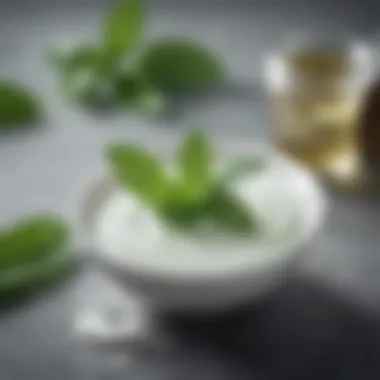Unlock the Secrets: Choosing the Perfect Toothpaste for Tea Stains


Beauty Tips & Hacks
When it comes to combatting stubborn tea stains on your teeth, selecting the right toothpaste is paramount for effective removal. Tea stains can be challenging to eliminate, requiring a toothpaste with specialized ingredients designed to tackle discoloration and prevent future staining. In this comprehensive guide, we will delve into the intricacies of selecting the best toothpaste specifically tailored to address tea stains, ensuring your smile remains bright and stain-free.
Makeup Techniques
Much like creating a flawless makeup look, choosing the best toothpaste requires attention to detail and technique. Just as makeup techniques are essential for achieving a desired look, utilizing the right toothpaste formula and application method is crucial for combating tea stains effectively. From selecting whitening agents to understanding the role of abrasives in toothpaste, we will explore the science behind removing tea stains to help you make an informed decision.
Skincare Routines
Maintaining a consistent skincare routine is akin to selecting the ideal toothpaste for combating tea stains - both require dedication and the right products for optimal results. Just as a skincare routine is customized to address specific skin concerns, choosing a toothpaste tailored to counter tea stains involves understanding your unique dental needs. From fluoride content to stain-removing agents, we will guide you through the essential components to look for in a toothpaste to safeguard your teeth from tea-related discoloration.
DIY Beauty Hacks
Engaging in do-it-yourself beauty hacks extends beyond skincare and hair care; it also encompasses selecting the best products for oral hygiene. DIY beauty hacks revolve around utilizing unconventional yet effective methods to enhance your beauty regimen. When it comes to selecting a toothpaste for tea stains, exploring unconventional ingredients and innovative formulas can make a significant difference in achieving a whiter and brighter smile. By uncovering DIY tips for selecting toothpaste tailored to combat tea stains, you can take control of your oral care routine and achieve remarkable results.
Understanding Tea Stains on Teeth
Tea stains on teeth are a common concern for many individuals, affecting not only the appearance of teeth but also oral health. Understanding the underlying causes of tea stains is crucial in selecting the most effective toothpaste. By diving into the components that lead to discoloration, individuals can make informed decisions to tackle and prevent tea stains. This section will elucidate the impact of tannins and pigment absorption, shedding light on how toothpaste can address these issues.
Causes of Tea Stains
Impact of Tannins
Tannins, naturally found in tea, play a significant role in staining teeth. These compounds have a strong affinity for binding to dental enamel, leading to discoloration over time. The astringent nature of tannins can leave teeth looking yellow or brownish. Toothpaste formulated to combat tannin-induced stains focuses on gentle yet effective cleansing to remove these stubborn discolorations. While tannins provide tea with its distinct flavor, they pose challenges for maintaining white teeth.
Pigment Absorption
Pigment absorption refers to the process where compounds in tea bind to tooth surfaces, resulting in visible stains. The deep color of tea can easily leave pigments behind, adhering to enamel and causing dullness. Toothpaste engineered to address pigment absorption leverages specialized ingredients that target and lift these stains effectively. By understanding how pigments interact with teeth, consumers can opt for toothpaste that offers advanced stain-removal capabilities.
Effectiveness of Toothpaste
Toothpaste plays a critical role in combating tea stains by employing specific mechanisms for stain removal and prevention. Understanding how toothpaste interacts with stains is fundamental to selecting the right product for individual needs. This section will delve into the mechanism of stain removal and prevention strategies, exploring the nuances of toothpaste formulations.


Mechanism of Stain Removal
The mechanism of stain removal in toothpaste involves abrasive agents and chemicals that break down and lift stains from enamel. Abrasive particles in toothpaste scrub away surface stains, while active ingredients penetrate deeper layers to dissolve stubborn discolorations. Toothpaste with advanced stain-removal mechanisms ensures thorough cleansing without damaging tooth enamel, providing a gentle yet efficient approach to combating tea stains.
Prevention Strategies
Prevention strategies in toothpaste focus on creating a protective barrier against future stains. By incorporating components that shield enamel from pigment absorption and tannin adhesion, these toothpastes help maintain a brighter smile over time. Prevention-oriented toothpaste formulations not only remove existing stains but also work proactively to minimize new discolorations. Choosing a toothpaste with robust prevention strategies can significantly improve oral health and aesthetics.
Key Considerations When Choosing Toothpaste
In the realm of oral hygiene, selecting the right toothpaste to combat tea stains is crucial. The abrasive properties of toothpaste play a pivotal role in removing these stubborn stains effectively. When choosing toothpaste, two significant elements to consider are the abrasive properties and whitening capabilities. These factors determine the toothpaste's ability to eliminate tea stains effectively and prevent their recurrence. Ultrafine abrasives are essential for gentle yet efficient stain removal, making toothpaste a powerful tool against tea stains.
Abrasive Properties
Microbead-Free Formulas
Microbead-Free formulas are gaining popularity due to their eco-friendly nature. They offer gentle yet powerful stain removal without harming the enamel. The absence of microbeads ensures a smooth texture, preventing any abrasive damage to the teeth while effectively scrubbing away tea stains. Dentists recommend microbead-free formulas for their safe and efficient stain removal abilities.
Gentle yet Effective Ingredients
Toothpaste containing gentle yet effective ingredients is ideal for combating tea stains. These ingredients work harmoniously to remove stains without causing sensitivity or irritation. The gentle nature of these components ensures that the enamel remains protected during the whitening process. By choosing toothpaste with gentle yet effective ingredients, individuals can achieve a brighter smile without compromising oral health.
Whitening Capabilities
Bleaching Agents
Bleaching agents are potent whitening components found in certain toothpaste formulas. These agents penetrate the teeth to break down and eliminate tough tea stains effectively. The key characteristic of bleaching agents lies in their ability to target deep-set discoloration, offering a noticeable whitening effect. While bleaching agents are powerful in stain removal, it is essential to use them as directed to prevent enamel damage.
Enzymatic Whitening
Enzymatic whitening refers to a natural whitening process that breaks down stains using enzymes. This method is safe and gentle on the teeth, making it an ideal choice for individuals with sensitive oral conditions. Enzymatic whitening effectively lifts tea stains without causing sensitivity, providing a brighter smile without harsh abrasives. The unique feature of enzymatic whitening lies in its ability to whiten teeth gradually and naturally.
Fluoride Content


Optimal Fluoride Levels
Toothpaste with optimal fluoride levels offers enhanced protection against cavities and strengthens enamel. Fluoride plays a crucial role in remineralizing the teeth, making them more resistant to tea stains. The key characteristic of optimal fluoride levels is their ability to fortify enamel, reducing the risk of staining. By choosing toothpaste with optimal fluoride levels, individuals can safeguard their oral health while combatting tea stains effectively.
Anti-Cavity Benefits
Incorporating anti-cavity benefits into toothpaste formulation helps prevent dental decay and enamel erosion. These benefits work synergistically with fluoride to create a robust defense against tea stains and cavities. The main advantage of anti-cavity benefits is their long-term protective effect on the teeth, ensuring oral health maintenance. By selecting toothpaste with anti-cavity benefits, individuals can tackle tea stains while maintaining optimal oral hygiene.
Top Recommendations for Toothpaste
Choosing the best toothpaste for addressing tea stains is a vital aspect of oral hygiene. The effectiveness of toothpaste in tackling stains and maintaining dental health is significant. When dealing with tea stains, opting for the right toothpaste can make a substantial difference. Good toothpaste options can help remove and prevent tea stains effectively, ensuring a brighter and healthier smile. Selecting toothpaste tailored to combating tea stains involves considering factors such as abrasive properties, whitening capabilities, and fluoride content.
Crest 3D White
Micro-Cleansing Crystals
Micro-Cleansing Crystals play a crucial role in the stain removal process. These innovative crystals work by gently lifting and eliminating surface stains, restoring the natural whiteness of teeth. Their unique feature lies in their ability to clean deeply yet safely, making them a popular choice for addressing stubborn tea stains. The advantage of Micro-Cleansing Crystals is their precision in targeting specific areas of discoloration, promoting a thorough cleaning action for improved stain removal results.
Gentle Whitening
Gentle Whitening is a key aspect to consider when selecting toothpaste for tea stains. This feature ensures that the whitening process is effective yet mild, preventing damage to the enamel. The gentle nature of whitening agents in the toothpaste helps safeguard the teeth while combating stains, maintaining overall oral health. The unique quality of Gentle Whitening lies in its ability to brighten teeth without causing sensitivity or discomfort, making it a beneficial choice for individuals looking to whiten their teeth without compromising enamel strength.
Colgate Optic White
Hydrogen Peroxide Formula
The Hydrogen Peroxide Formula is a significant component that contributes to the toothpaste's stain-fighting capabilities. This formula effectively breaks down and lifts tough stains, including those caused by tea pigments. Its key characteristic is its powerful oxidizing properties, which penetrate deep into the enamel to eradicate deep-seated stains. The unique feature of the Hydrogen Peroxide Formula is its ability to provide quick and noticeable whitening results, making it a popular choice for individuals seeking rapid stain removal.
Stain-Preventing Technology
Stain-Preventing Technology is a vital element in toothpaste designed to combat tea stains and prevent their recurrence. This technology works by forming a protective barrier on the tooth's surface, shielding it from stain-causing agents present in tea and other beverages. Its key characteristic lies in its long-lasting effect, ensuring that teeth remain stain-free for an extended period. The unique feature of Stain-Preventing Technology is its ability to provide continual protection against new stains, offering lasting stain prevention benefits.
Sensodyne Pronamel Gentle Whitening


Enamel Protection
Enamel Protection is a crucial feature in toothpaste for individuals with sensitive teeth or enamel erosion concerns. This aspect focuses on strengthening and protecting the enamel, reducing the risk of damage when addressing stains. The key characteristic of Enamel Protection is its ability to fortify the enamel against acid erosion and abrasive action, maintaining tooth integrity. The unique feature of Enamel Protection is its gentle yet effective formulation, making it an ideal choice for individuals seeking to whiten their teeth without compromising enamel health.
Acid Erosion Defense
Acid Erosion Defense is paramount for individuals who consume acidic beverages like tea that can wear down the enamel and contribute to staining. This feature works by neutralizing acid attacks on the teeth, minimizing enamel erosion and discoloration. The key characteristic of Acid Erosion Defense is its p H-balancing properties, which help restore the mouth's natural balance after exposure to acidic substances. The unique feature of Acid Erosion Defense is its ability to strengthen the enamel against acid damage, offering comprehensive protection against tea stains and acid-related tooth issues.
Additional Tips for Tea Stain Prevention
Tea stains on teeth can be persistent and bothersome. In this article, we delve into the significance of additional tips for preventing these stubborn stains. By implementing specific strategies, one can effectively minimize the impact of tea stains on dental aesthetics and health. The inclusion of additional tips underscores the holistic approach to oral care, extending beyond just toothpaste selection. These tips serve as a supplementary arsenal in combating tea stains, offering practical insights and long-term benefits.
Regular Dental Visits
Professional Cleanings
Professional cleanings play a pivotal role in maintaining oral health and combating tea stains. These professional cleanings are essential in removing built-up plaque and tartar that regular brushing may miss. The skilled hands of dental professionals ensure a thorough cleaning process, reaching areas that are hard to access with daily oral hygiene practices. By opting for professional cleanings regularly, individuals can significantly reduce the risk of tea staining and maintain overall oral health.
Advice from Dentists
The guidance provided by dentists is invaluable in the prevention of tea stains. Dentists offer personalized advice based on individual oral health needs, emphasizing preventive measures and treatment options. Their expert recommendations on oral care routines, dietary habits, and stain-prevention techniques can make a profound difference in reducing tea stains. By heeding the advice of dentists and incorporating their recommendations into daily oral hygiene practices, one can proactively address the issue of tea staining and achieve optimal dental health.
Moderating Tea Consumption
Limiting Intake
Moderating tea consumption is key to minimizing the onset of tea stains on teeth. By limiting the frequency and quantity of tea intake, individuals can reduce the exposure of teeth to staining compounds present in tea. This proactive approach helps in controlling the extent of staining and preserves the natural whiteness of teeth. Limiting tea intake, especially strong and dark varieties, can significantly lower the risk of stubborn stains, contributing to a brighter and healthier smile.
Using Straws
Utilizing straws while consuming tea can be an effective strategy in preventing direct contact between tea and teeth. Straws help in directing the flow of tea towards the back of the mouth, bypassing the front teeth that are more prone to staining. This simple yet practical measure minimizes the contact time of tea with the tooth surfaces, reducing the likelihood of significant discoloration. Introducing straws as a regular accompaniment to tea drinking habits can be a proactive step towards preserving dental aesthetics and preventing tea stains.
Optimal Brushing Techniques
Gentle Circular Motions
The technique of gentle circular motions during brushing is paramount in mitigating tea stains and maintaining oral hygiene. This brushing method ensures thorough cleaning of tooth surfaces, targeting areas where stains may accumulate. The gentle yet effective motion helps in dislodging plaque and preventing the adherence of staining particles. By incorporating gentle circular motions into daily brushing routines, individuals can enhance stain removal and promote overall dental cleanliness.
Thorough Rinsing
Thorough rinsing post-tea consumption is vital in preventing tea stains from settling on teeth. Rinsing with water immediately after drinking tea helps in washing away residual tea particles that can contribute to staining. Additionally, rinsing aids in maintaining oral p H balance and reducing the impact of acidic components present in tea. This practice not only refreshes the mouth but also serves as a protective measure against the development of undesirable tea stains. Through consistent and thorough rinsing habits, individuals can safeguard their teeth from stubborn discoloration and uphold dental hygiene standards.



